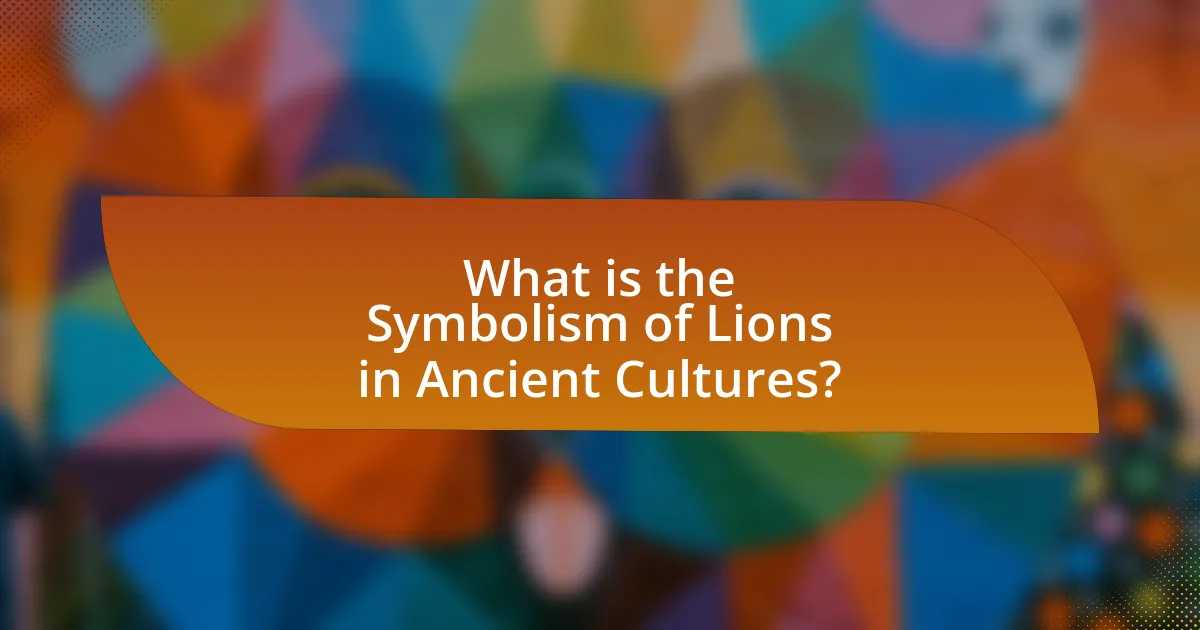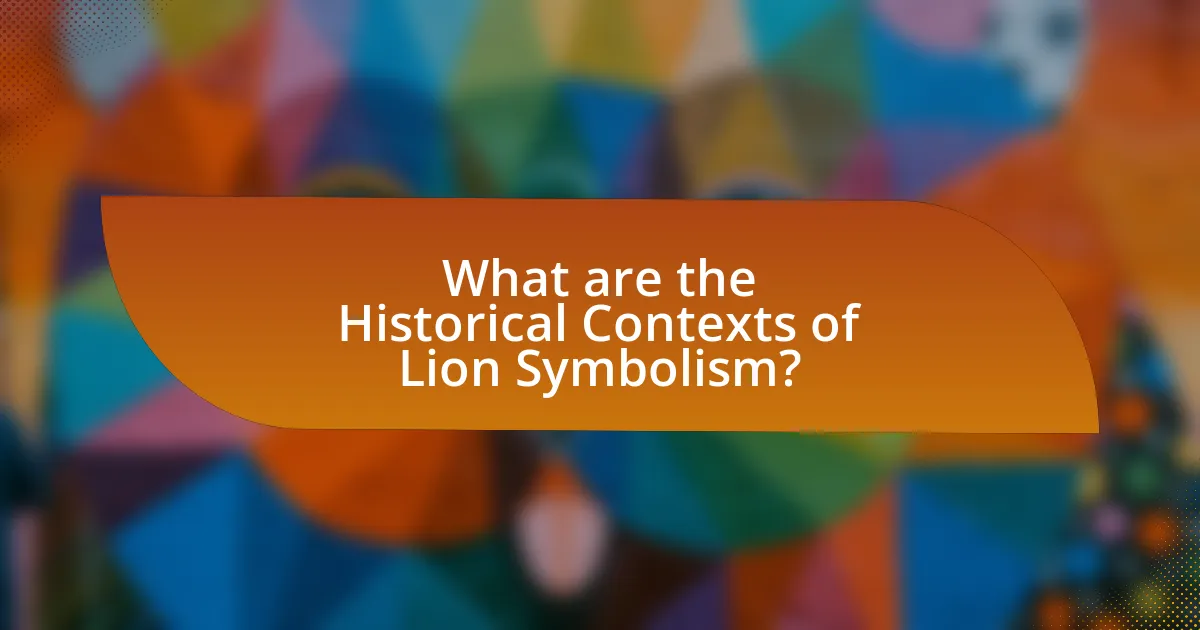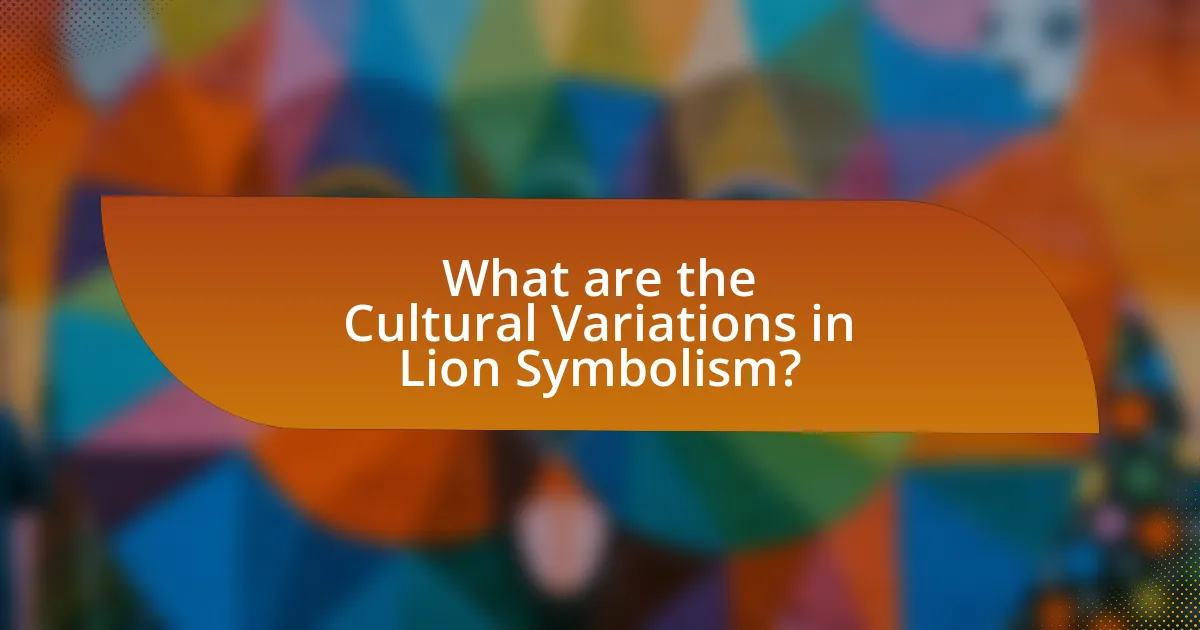The article examines the symbolism of lions in ancient cultures, highlighting their representation of strength, courage, and royalty across various civilizations. It explores the significance of lions in ancient Egypt, Mesopotamia, Greece, and China, detailing their roles in mythology, art, and architecture. Key themes include the attributes commonly associated with lions, their depiction in sculptures, and the cultural variations in their symbolism. The article also discusses how historical contexts, trade, and cultural exchange influenced the perception of lions, as well as modern interpretations of ancient lion symbolism in contemporary society.

What is the Symbolism of Lions in Ancient Cultures?
Lions symbolize strength, courage, and royalty in ancient cultures. In ancient Egypt, lions were associated with the sun god Ra and represented protection and power, often depicted in sculptures guarding temples. Similarly, in Mesopotamia, lions symbolized kingship and were featured in the art of Assyrian palaces, signifying the ruler’s strength and divine right to govern. In ancient Greece, the Nemean lion represented invincibility and was famously slain by Hercules, further embedding the lion’s symbolism of heroism and triumph in cultural narratives. These examples illustrate the lion’s enduring representation of authority and valor across various ancient civilizations.
Why are lions significant in various ancient cultures?
Lions are significant in various ancient cultures primarily due to their representation of strength, courage, and royalty. In ancient Egypt, lions symbolized protection and were associated with the goddess Sekhmet, who embodied war and healing. Similarly, in Mesopotamia, lions were depicted in art and architecture, signifying power and divine authority, as seen in the Ishtar Gate of Babylon, which features lion motifs. Additionally, in ancient Greece, lions were linked to the hero Heracles and his twelve labors, reinforcing their status as symbols of bravery and heroism. These cultural associations highlight the lion’s enduring legacy as a powerful emblem across civilizations.
What attributes are commonly associated with lions in these cultures?
Lions are commonly associated with attributes such as strength, courage, and nobility in various cultures. In ancient Egypt, lions symbolized protection and were often depicted as guardians of the pharaohs, reflecting their power and authority. Similarly, in Mesopotamian cultures, lions represented divine strength and were associated with deities like Ishtar, emphasizing their role as symbols of war and protection. In heraldry, lions are frequently used to signify bravery and valor, reinforcing their status as kings of the animal kingdom. These associations are rooted in the lion’s physical prowess and social behavior, which have made them enduring symbols of leadership and dominance across different civilizations.
How do different cultures interpret the symbolism of lions?
Different cultures interpret the symbolism of lions as representations of strength, courage, and royalty. In ancient Egypt, lions symbolized protection and were associated with the goddess Sekhmet, who embodied war and healing. In contrast, in Chinese culture, lions are seen as guardians, often depicted in stone sculptures at the entrances of buildings to ward off evil spirits. Additionally, in European heraldry, lions represent nobility and valor, frequently appearing on coats of arms to signify bravery and leadership. These interpretations highlight the lion’s universal association with power and authority across various civilizations.
What roles do lions play in mythology and folklore?
Lions serve as powerful symbols in mythology and folklore, often representing strength, courage, and nobility. In various cultures, such as ancient Egypt, lions were associated with deities like Sekhmet, embodying protection and ferocity. Similarly, in Greek mythology, the Nemean Lion was a formidable creature defeated by Hercules, symbolizing the hero’s strength and bravery. Additionally, in Hindu mythology, the goddess Durga is depicted riding a lion, signifying her power and authority. These examples illustrate that lions frequently embody themes of leadership, protection, and divine power across different mythological narratives.
Which myths feature lions as central figures?
Myths that feature lions as central figures include the Nemean Lion from Greek mythology, which was slain by Hercules as one of his twelve labors. Additionally, the lion is a prominent figure in the Mesopotamian myth of Gilgamesh, where it symbolizes strength and courage. In Hindu mythology, the goddess Durga rides a lion, representing power and protection. These examples illustrate the lion’s significance across various cultures, often embodying attributes such as bravery, strength, and divine protection.
How do these myths reflect the values of the cultures they originate from?
Myths reflect the values of the cultures they originate from by embodying the beliefs, morals, and social norms prevalent in those societies. For instance, in ancient cultures, lions often symbolize strength, courage, and royalty, which aligns with the values of power and leadership that were revered in societies such as Mesopotamia and Egypt. The lion’s portrayal in myths, such as the Sumerian goddess Inanna riding a lion, illustrates the connection between divine authority and the qualities associated with lions, reinforcing the cultural ideal of a strong, protective leader. Additionally, the reverence for lions in these myths underscores the importance of bravery and valor in warfare, reflecting the societal emphasis on military prowess and protection of the community.
How are lions represented in ancient art and sculptures?
Lions are represented in ancient art and sculptures as symbols of strength, power, and royalty. In various cultures, such as Ancient Egypt and Mesopotamia, lions were often depicted in a majestic posture, emphasizing their dominance and ferocity. For instance, the Lion of Babylon, a significant sculpture from the ancient city of Babylon, showcases a lion in a powerful stance, symbolizing the might of the Babylonian empire. Similarly, in Ancient Egypt, lions were associated with the goddess Sekhmet, representing protection and warfare, often portrayed in statues and reliefs as fierce and protective figures. These artistic representations reflect the cultural reverence for lions as guardians and symbols of authority throughout ancient civilizations.
What are the common styles and techniques used in lion sculptures?
Common styles and techniques used in lion sculptures include realism, stylization, and abstraction. Realism focuses on accurately depicting the physical characteristics and expressions of lions, often seen in classical sculptures from ancient Greece and Rome, where attention to detail in fur and anatomy is paramount. Stylization simplifies forms and emphasizes certain features, as seen in Asian art, where lions are often depicted with exaggerated manes and postures to convey strength and majesty. Abstraction, on the other hand, distills the essence of the lion into geometric shapes or symbolic representations, prevalent in modern art movements. These techniques reflect cultural values and artistic trends, demonstrating how lions symbolize power, courage, and protection across various civilizations.
How do these artistic representations vary across different civilizations?
Artistic representations of lions vary significantly across different civilizations, reflecting unique cultural values and beliefs. In ancient Mesopotamia, lions symbolized power and protection, often depicted in sculptures guarding entrances to palaces, such as the Lion of Babylon. In contrast, ancient Egyptian art portrayed lions as symbols of royalty and divine protection, exemplified by the Sphinx, which combines human and lion features to represent strength and wisdom. Meanwhile, in ancient Greece, lions were associated with heroism and were frequently depicted in mythology, such as the Nemean Lion in the Twelve Labors of Heracles, emphasizing bravery and conquest. These variations illustrate how each civilization imbued the lion with distinct meanings, influenced by their social structures, religious beliefs, and artistic conventions.

What are the Historical Contexts of Lion Symbolism?
Lion symbolism has deep historical contexts rooted in various ancient cultures, where lions represented power, courage, and nobility. In Mesopotamia, lions were associated with deities such as Ishtar and were often depicted in art and architecture to symbolize strength and protection. Ancient Egyptians revered lions as symbols of royalty and protection, exemplified by the Sphinx, which combines human and lion features to signify strength and wisdom. In ancient Greece, lions were linked to the hero Heracles, representing bravery and the triumph over challenges, as seen in the Nemean Lion myth. Furthermore, in Chinese culture, lions symbolize protection and are often depicted in guardian statues, known as “Foo dogs,” which were believed to ward off evil spirits. These historical contexts illustrate the lion’s enduring significance across civilizations as a symbol of authority and guardianship.
How did the symbolism of lions evolve over time?
The symbolism of lions evolved from representations of power and royalty in ancient cultures to broader meanings of courage and protection in later societies. Initially, lions were revered in civilizations such as Mesopotamia and Egypt, where they symbolized strength, divine protection, and the authority of kings, as evidenced by the lion sculptures found in the Ishtar Gate of Babylon and the Sphinx of Giza. Over time, in cultures like ancient Greece and Rome, lions began to embody virtues such as bravery and valor, often depicted in mythology and art as guardians of the underworld or symbols of heroic deeds. This evolution reflects a shift from a focus on monarchy and divinity to a more universal representation of human qualities, as seen in heraldry where lions became emblems of nobility and courage.
What historical events influenced the perception of lions?
The perception of lions has been significantly influenced by historical events such as the rise of ancient civilizations, including Mesopotamia, Egypt, and Greece, where lions were often depicted in art and mythology as symbols of power and royalty. For instance, in ancient Egypt, the lioness goddess Sekhmet represented both destruction and protection, reflecting the duality of lions in society. Additionally, the Assyrian Empire showcased lion hunting as a royal sport, emphasizing the lion’s status as a symbol of strength and bravery. These cultural representations solidified the lion’s image as a majestic and formidable creature throughout history.
How did trade and cultural exchange affect lion symbolism?
Trade and cultural exchange significantly influenced lion symbolism by facilitating the spread of artistic styles and religious beliefs across different civilizations. For instance, as trade routes expanded during the ancient Near Eastern and Mediterranean periods, motifs of lions were adopted and adapted by various cultures, such as the Egyptians, Mesopotamians, and Greeks. This interchange led to a shared understanding of lions as symbols of power, protection, and divinity, evident in artifacts like the Lion Gate at Mycenae and the Assyrian lion hunt reliefs. The cross-cultural interactions enriched the iconography associated with lions, reinforcing their status as emblems of strength and royalty across diverse societies.
What are some notable examples of lion sculptures in ancient architecture?
Notable examples of lion sculptures in ancient architecture include the Lion of Babylon, which dates back to the 6th century BCE and is a prominent feature of the Ishtar Gate, showcasing the significance of lions in Mesopotamian culture. Another example is the Lion Statues at the entrance of the ancient city of Mycenae in Greece, known as the Lion Gate, which dates to around 1250 BCE and symbolizes power and protection. Additionally, the Sphinx of Giza, constructed around 2500 BCE, features a lion’s body with a human head, representing strength and wisdom in ancient Egyptian culture. These sculptures reflect the cultural importance of lions as symbols of strength, protection, and royalty in various ancient civilizations.
Where can we find significant lion sculptures today?
Significant lion sculptures can be found in various locations around the world, including the British Museum in London, which houses the famous Lion of Babylon, and the Metropolitan Museum of Art in New York, known for its Assyrian lion reliefs. Additionally, the Lion of Lucerne in Switzerland and the iconic lions at the entrance of the New York Public Library are notable examples. These sculptures represent the cultural significance of lions in ancient civilizations, often symbolizing strength and protection.
What do these sculptures tell us about the societies that created them?
These sculptures reveal that the societies that created them held lions in high regard, often symbolizing power, strength, and protection. For instance, in ancient Mesopotamia, lion sculptures were frequently used in royal contexts, indicating the ruler’s authority and divine protection, as seen in the Ishtar Gate of Babylon, which features lion reliefs that signify the goddess Ishtar’s strength. Similarly, in ancient Egypt, lion imagery was associated with the sun god Ra and the goddess Sekhmet, reflecting the cultural belief in the lion as a protector and a symbol of royalty. These artistic representations demonstrate the societies’ values, beliefs, and their reverence for the lion as a significant cultural icon.

What are the Cultural Variations in Lion Symbolism?
Cultural variations in lion symbolism reflect diverse interpretations across different societies. In ancient Egypt, lions symbolized power and protection, often associated with the goddess Sekhmet, who represented war and healing. In contrast, in Asian cultures, particularly in China, lions are seen as guardians, often depicted in stone sculptures at temple entrances to ward off evil spirits. In African cultures, lions embody strength and bravery, frequently appearing in folklore and tribal art as symbols of leadership and courage. These variations highlight how the lion’s attributes are adapted to fit the values and beliefs of different cultures, demonstrating its universal significance as a symbol of strength and protection.
How do Eastern cultures view lions differently from Western cultures?
Eastern cultures often view lions as symbols of protection and guardianship, while Western cultures typically associate them with nobility and strength. In Eastern traditions, particularly in Chinese culture, lions are often depicted as guardian figures, known as “Fu Lions” or “Stone Lions,” placed at the entrances of temples and palaces to ward off evil spirits. This protective symbolism contrasts with the Western portrayal of lions as majestic and powerful creatures, often representing courage and leadership, as seen in heraldry and literature. Historical evidence, such as the use of lion statues in ancient Chinese architecture and the prevalence of lions in Western coats of arms, illustrates these differing cultural significances.
What specific symbols or meanings do lions hold in Eastern traditions?
Lions symbolize strength, courage, and protection in Eastern traditions. In Hinduism, lions are associated with the goddess Durga, representing power and victory over evil. In Chinese culture, lions are seen as guardians, often depicted in stone sculptures at entrances to homes and temples, symbolizing protection and prosperity. Additionally, in Buddhism, lions represent the Buddha’s teachings, embodying fearlessness and the ability to overcome obstacles. These meanings are reinforced by historical artifacts and texts, such as the lion statues found in ancient temples and the references in religious scriptures that highlight their significance in various Eastern cultures.
How do Western interpretations of lions contrast with those of Eastern cultures?
Western interpretations of lions often symbolize strength, courage, and nobility, frequently associated with royalty and power, as seen in heraldry and literature. In contrast, Eastern cultures, particularly in regions like India and China, view lions as protectors and guardians, embodying spiritual significance and often linked to deities, as evidenced by the presence of lion statues at temple entrances. This divergence highlights how Western cultures emphasize individual valor and authority, while Eastern cultures focus on communal protection and spiritual guardianship.
What modern interpretations of ancient lion symbolism exist?
Modern interpretations of ancient lion symbolism often emphasize themes of strength, courage, and leadership. In contemporary culture, lions are frequently used as emblems of power in corporate branding, representing authority and confidence. For instance, the lion is a prominent symbol in heraldry, where it signifies bravery and nobility, reflecting its historical role as a guardian and protector in various ancient civilizations, such as in Mesopotamia and Egypt. Additionally, in literature and media, lions are depicted as noble characters, reinforcing their association with valor and integrity. This continuity of meaning illustrates how ancient lion symbolism has been adapted to resonate with modern values of strength and leadership.
How are ancient lion symbols used in contemporary art and culture?
Ancient lion symbols are utilized in contemporary art and culture as representations of strength, courage, and nobility. Artists and designers often incorporate lion imagery into sculptures, paintings, and fashion to evoke these qualities, reflecting the historical significance of lions in various ancient civilizations, such as Mesopotamia and Egypt, where they symbolized power and protection. For instance, the use of lion motifs in modern architecture and public art can be traced back to their roles as guardians in ancient cultures, reinforcing their status as symbols of authority and valor. This continuity demonstrates the lasting impact of ancient lion symbolism on contemporary artistic expressions and cultural narratives.
What lessons can modern societies learn from ancient lion symbolism?
Modern societies can learn the importance of strength, courage, and leadership from ancient lion symbolism. In various cultures, lions have represented power and authority, often depicted in royal insignia and architecture, such as the Lion of Babylon and the Sphinx of Giza. These symbols conveyed the idea that effective leadership requires bravery and the ability to protect one’s community. Additionally, the lion’s role in mythology, such as in the stories of Hercules or the Lion of Judah, emphasizes the value of resilience and moral integrity. By understanding these attributes, contemporary societies can foster leadership qualities that promote unity and strength in facing challenges.
What practical insights can we gain from studying lion symbolism in ancient cultures?
Studying lion symbolism in ancient cultures provides practical insights into the values and beliefs of those societies. For instance, lions often represented strength, courage, and royalty, as evidenced by their frequent depiction in the art and architecture of civilizations such as ancient Egypt and Mesopotamia. In Egypt, the lion-headed goddess Sekhmet symbolized power and protection, reflecting the cultural importance of lions in asserting authority and divine favor. Additionally, the presence of lion motifs in royal insignia across various cultures indicates their role in legitimizing leadership and social hierarchy. This understanding of lion symbolism can inform contemporary interpretations of power dynamics and cultural identity.


